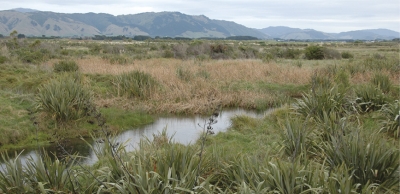World Wetlands Day and beyond
 Otaki River: Water birds and other wildlife are benefiting from estuary restoration efforts.
Liz Brook
Otaki River: Water birds and other wildlife are benefiting from estuary restoration efforts.
Liz Brook
The plight of the world’s wetlands is highlighted annually by World Wetlands Day, and the 2011 celebration also coincided with the 40th anniversary of the Ramsar Convention - an international agreement to promote and protect freshwater environments. See page 14.
Since the agreement was signed in 1971, 186 million hectares of wetlands have been protected throughout the world - including 55,000ha in New Zealand.
Since European settlement New Zealand has lost more than 90 percent of its wetlands - many drained to create farmland and supposedly help with flood control.
Now the Department of Conservation (DOC) and community groups are working to redress the balance aiming to educate people about the importance of wetlands - rated amongst the most important, productive and highly threatened ecosystems in the world.
Wetlands provide a range of crucial ecosystem services such as improving water quality, controlling extreme flooding, regulating carbon levels and supplying fresh water.
Threatened wildlife
DOC refers to wetlands as “cradles of biological diversity” and says they support a high number of threatened plants and animals, as well as providing the greatest concentration of birdlife than any other habitat in New Zealand.
Wetlands are especially important to Māori and have historical importance having provided abundant supplies of food and materials used in everyday life during early times. Flax was used in clothing, mats, kits and ropes; raupo for thatching and dried moss for bedding. Eels, fish and birds from the wetlands were a good food source, and the feathers of birds like the pukeko and bittern were used to adorn cloaks and other garments. The waterways were also an important means of access by waka or canoe. New Zealand species New Zealand wetlands have exceptional habitats - 47 species of rush and 72 species of native sedge alone - as well as a number of endangered plant species that totally depend on the wetland environment.
Migratory birds also depend on chains of suitable wetlands and the survival of threatened species such as the Australasian bittern, brown teal, fernbird, marsh crake and white heron all rely on New Zealand’s remnant wetland areas.
Native fish also need wetlands and eight of New Zealand’s 27 species including inanga, short-finned eels, kokopu and bullies are found in wetlands. Whitebait also spawn in freshwater wetlands.
Image Gallery
https://ducks.org.nz/flight-magazine/item/313-world-wetlands-day-and-beyond#sigProId880c13f9d6

